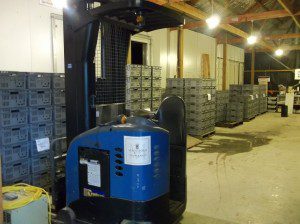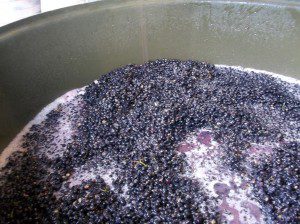11 Apr Day 3 of Harvest at Mountford
Today was a rainy day. Not ideal for this time of year but we got all the grapes off the Gradient and Rise vineyards before the rain and the other grapes still need a little more time to ripen. Of course, the rain isn’t helping but the forecast for tomorrow is sun again. Despite the rain, we had plenty to do today. Now that we had grapes in from the vineyard, it was time to start the winemaking process.



 We had three lots: the grapes from the lower part of the Gradient Vineyard, the grapes from the top of the Gradient Vineyard and the grapes from the Rise Vineyard. Each lot is kept separate.
We began with the grapes from the lower part of the Gradient Vineyard. With these grapes, we put them through the destemmer which gently removed the stems from the grapes.
We had three lots: the grapes from the lower part of the Gradient Vineyard, the grapes from the top of the Gradient Vineyard and the grapes from the Rise Vineyard. Each lot is kept separate.
We began with the grapes from the lower part of the Gradient Vineyard. With these grapes, we put them through the destemmer which gently removed the stems from the grapes.










The whole grape clusters from the upper part of Gradient and from the Rise Vineyard were placed into two large fermenters and we, the harvest team, jumped in and stomped the grapes, allowing a very gentle crushing of the grapes.
The fermenter for the Gradient Pinot Noir was filled with 1005 kilos / 2216 pounds of grapes. The fermenter for the Rise Pinot Noir was filled with 1260 kilos / 2778 pounds of grapes. Needless to say, we started stomping on top of the grapes but ended up submerged up to our mid-thighs. There were a lot of grapes to stomp! It was cold, some of the stems were a bit rough on the feet and it was a very sticky experience (plus I can’t say I enjoyed the spiders that were trying to escape their ultimate demise in grape juice) but it was a lot of fun and a very cool sensation.



The yeast was then added. To prepare the yeast, it was poured into very warm water and left to “rise”. It was stirred after 15 minutes and then after another 15 minutes, it was stirred and poured into the top of each fermenter.
Now we wait for fermentation to take place. This will be anywhere from 1-2 weeks, during which the fermenters will be plunged daily in order to regularly blend the skins and the juice.Discover more from Please The Palate
Subscribe to get the latest posts sent to your email.












